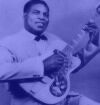Shades R&B; History - 2
Rhythm and Blues is perhaps most commonly understood as the term used to describe the sophisticated urban music that grew out of the urbanisation of the blues which began in the 1930s. The single and most renowned exponent of this development is Louis Jordan who, originally with a relatively small band, began to make blues based records with humorous lyrics and a rhythm owing as much to boogie woogie as to the more traditional classic blues form. Jordan, Amos Milburn, Floyd Dixon, Charles Brown and even the great Joe Turner were all leading practitioners of what came to be known as jump blues. What distinguished many of these artists was the sheer breadth of material played - straight 12 bar, instrumentals, blues ballads and straight pop songs were all part of the scene at that time.
 |
| Howlin' Wolf |
The early centre of recorded rhythm and blues tended to be Los Angeles, usually via a series of small independents such as Modern, RPM and Specialty. One of the major advances for the genre was the development of an R&B roster within Atlantic Records, where Ahmet Ertegun and Jerry Wexler, along with engineer Tom Dowd, proved instrumental in shifting R&B to a wider audience. They showcased some of the great female names in R&B, including Ruth Brown and Lavern Baker and, of course, they recorded one of the greats of modern black American music - the wonderful Ray Charles.
Atlantic also worked closely with the likes of Clyde McPhatter and Chuck Willis throughout this period and such artists, along with the aforementioned Ray Charles, can now be seen as the clear links between the blues and R&B of the 1940s and 50s and the classic soul of the 1960s and early 70s. And let's not forget the even smaller independents, such as Duke/Peacock, all of whom played pivotal roles in the spread of R&B and the evolution of the music into what became known as soul; and of course the Duke label was also responsible for recording the great Bobby Bland at the height of his not inconsiderable vocal powers.
| Lavern Baker |
The division and categorisation based on the age of the intended audience also meant that during this period much of the guitar led electric blues coming out of Chicago or Memphis was now considered R&B, since it clearly appealed largely to the older age group. All of these factors helps to explain why the Primer attempts to cover the range of artists it does, rather than rely on too narrow a definition of what might constitute Rhythm and Blues!!!
So, artists such as Muddy Waters, Howlin' Wolf and B.B. King (who often used a horn section and owed much to the sounds of Louis Jordan) were now treated as Rhythm and Blues performers
By the early 1960s rhythm and blues, in its narrowest sense, was an ageing and waning genre, certainly from the perspective of straight record sales. But as we now know, rightly or wrongly, the Primer doesn't hold to any highly restrictive definition of the term and as R&B evolved, like the blues had before it, the golden age of 60s soul was born.